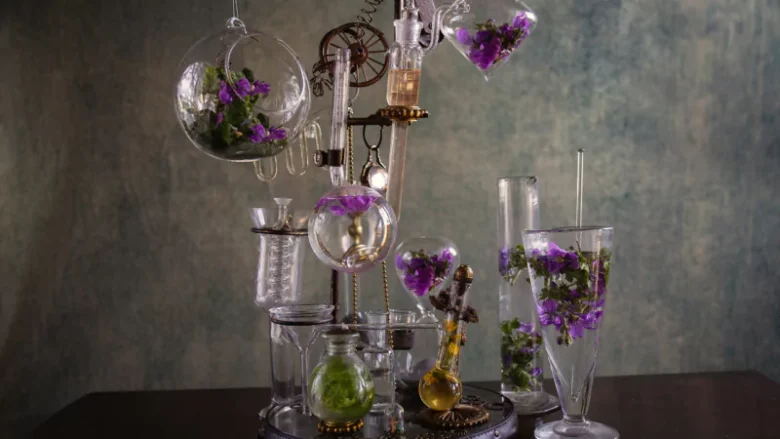“Perfumery is the art of extracting the soul of the matter and distilling it into a fragrance that will live forever.”
– anonymous
The method to extract and distill fragrances is a complex process that requires a deep understanding of the materials and techniques used. There are several different methods used to extract and distill fragrances from natural materials, each with its own set of advantages and disadvantages.
Steam distillation: One of the prevalent techniques employed is steam distillation, which entails subjecting the raw materials, like flowers, leaves, or roots, to a gentle yet invigorating infusion of steam. Through this process, the sublime essential oils gracefully emancipate from their botanical origins. Subsequently, the steam laden with the precious essential oils is thoughtfully condensed and meticulously collected. The final step entails skillfully isolating the coveted essential oils from the accompanying water. Recognized for its simplicity and cost-effectiveness, steam distillation stands as a favored method widely employed in extracting essential oils from a diverse array of plants. This versatile technique adeptly captures the aromatic essence of lavender, peppermint, rosemary, and countless other botanical wonders, weaving nature’s fragrance into a tapestry of sensory delight.
Solvent extraction: This method involves using a solvent, such as ethanol or hexane, to extract the essential oils from the raw materials. The solvent is then removed from the essential oils, leaving behind a concentrated, highly fragrant oil. Solvent extraction is a more complex and expensive method than steam distillation, but it is often used to extract essential oils from delicate or fragile materials, such as jasmine or rose petals, that would be damaged by steam distillation.
Enfleurage: An additional method worth noting is enfleurage, which employs the utilization of a fatty substance, such as lard or vegetable oil, to capture the exquisite aromatic molecules from the raw materials. In this process, the fat lovingly cradles the fragrant essence, absorbing it with tender care. To extract the precious essential oils, the saturated fat is gently washed with alcohol, facilitating the separation of the desired fragrance from the fat. While enfleurage stands as a relatively uncommon technique, it finds its niche in extracting essential oils from delicate blossoms, including the ethereal jasmine and intoxicating tuberose. These fragile flowers, often too delicate for steam distillation or solvent extraction, find their essence effortlessly captured through the gentle embrace of enfleurage. This time-honored method serves as a testament to the ingenuity and adaptability employed in the art of perfumery, allowing for the preservation of nature’s most delicate aromas.
CO2 extraction: This method involves using liquid CO2 as a solvent to extract essential oils from the raw materials. This method is considered as a safe and mild method, and it is often used to extract essential oils from delicate and fragile materials.
In addition to the aforementioned techniques, there exist a plethora of alternative approaches to extracting fragrances from natural materials, encompassing methodologies like maceration and expression. These additional methods offer distinct merits and drawbacks, presenting the perfumer with a tapestry of choices. The selection of the most fitting technique depends on a careful evaluation of the specific characteristics of the raw materials employed and the desired outcome sought by the perfumer. By navigating this multifaceted decision-making process, the perfumer ensures an optimal match between the chosen extraction method and the ultimate vision for the fragrance, leading to a harmonious union of nature’s essence and olfactory artistry.
Extracting and distilling fragrances from natural materials is a complex process that requires a deep understanding of the materials and techniques used. There are several different methods used to extract and distill fragrances from natural materials, including steam distillation, solvent extraction, enfleurage and CO2 extraction, each with its own set of advantages and disadvantages. The perfumer must choose the best method based on the raw materials and the desired end result to create a unique and memorable fragrance.
The different methods used to extract and distill fragrances from natural materials
The different methods used to extract and distill fragrances from natural materials, The different methods used to extract and distill fragrances from natural materials, The different methods used to extract and distill fragrances from natural materials The different methods used to extract and distill fragrances from natural materials
Are there any specific perfumes recommended for different age groups?









Leave a Reply